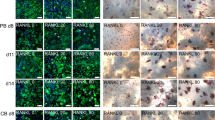Summary
Osteoclastlike cells (OLCs) were recognized by their morphological, histochemical, and behavioral characteristics. These characteristics were initially observed in freshly isolated osteoclasts when neonatal rat bone cells were introduced into culture. Epithelioid cells proliferated during the first week to form a confluent layer. The cells' alkaline phosphatase content andability to produce elevated levels of cyclic adenosine monophosphate in response to parathyroid hormone (PTH) led us to tentatively describe them as osteoblastlike cells. When a second addition of neonatal bone cells was made onto this confluent layer, OLCs were produced, their numbers increasing to a maximum 7 days later and dying out 3 weeks later. Mononuclear cells with similar characteristics to these multinuclear OLCs were observed and their production and disappearance closely paralled that of the OLCs. Fusion of OLCs was observed. The conditions under which OLCs were produced are described.
Similar content being viewed by others
References
Ash P, Loutit JF, Townsend KMS (1981) Osteoclasts derive from hematopoietic stem cells according to marker, giant lysosomes of beige mice. Clin Orthop 155:249–258
Tinkler SMB, Williams DM, Linder JE, Johnson NW (1983) Kinetics of osteoclast formation: the significance of blood monocytes as osteoclast precursors during 1α-hydroxycholecalciferol-stimulated bone resorption in the mouse. J Anat 137:335–340
Horton MA, Rimmer EF, Moore A, Chambers TJ (1985) On the origin of the osteoclast: the cell surface phenotype of rodent osteoclasts. Calcif Tissue Int 37:46–50
Hancox NM, Boothroyd B (1961) Motion picture and electron microscope studies on the embryonic avian osteoclast. J Biophys Biochem Cytol 11:651–661
Zallone AZ, Teti A, Primavera MV (1982) Isolated osteoclasts in primary culture: first observations on structure and survival in culture media. Anat Embryol 165:405–413
Zallone AZ, Teti A, Primavera MV (1984) Resorption of vital or devitalized bone by isolated osteoclasts in vitro. The role of lining cells. Cell Tissue Res 235:561–564
Burger EH, Van Der Meer, JWM, Van De Gevel JS, Gribnau JC, Thesingh CW, Van Furth R (1982) In vitro formation of osteoclasts from long-term cultures of bone marrow mononuclear phagocytes. J Exp Med 156:1604–1614
Burger EH, Van Der Meer JWM, Nijweide PJ (1984) Osteoclast formation from mononuclear phagocytes: role of bone-forming cells. J Cell Biol 99:1901–1906
Allen TD, Testa NG, Suda T, Schor SL, Onions D, Jarrett O, Boyde A (1981) The production of putative osteoclasts in tissue culture—ultrastructure, formation and behavior. Scan Electron Microsc 22:347–354
Ibbotson KJ, Roodman GD, McManus LM, Mundy GR (1984) Identification and characterization of osteoclast-like cells and their progenitors in cultures of feline marrow mononuclear cells. J Cell Biol 99:471–480
Osdoby P, Martini MC, Caplan AI (1982) Isolated osteoclasts and their presumed progenitor cells, the monocyte, in culture. J Exp Zool 224:331–334
Chambers TJ, Magnus CJ (1982) Calcitonin alters behaviour of isolated osteoclasts. J Pathol 136:27–39
Green PM, Marshall MJ, Nisbet NW (in press) A study of osteoclasts on calvaria of normal and osteopetrotic (mi/mi) mice by vital staining with acridine orange. Br J Exp Pathol
Evans RA, Dunstan CR, Baylink DJ (1979) Histochemical identification of osteoclasts in undecalcified sections of human bone. Miner Electrolyte Metab 2:179–185
Burnstone MS (1958) Histochemical comparison of naphthol-as-phosphates for the demonstration of phosphatases. J Natl Cancer Inst 20:601–615
Wong GL, Kocour BA (1983) Differential sensitivity of osteoclasts and osteoblasts suggests that prostaglandin E1 effects on bone may be mediated primarily through the osteoclasts. Arch Biochem Biophys 224:29–35
Chambers TJ (1985) The pathobiology of the osteoclast. J Clin Pathol 38:241–252
Eggert FM (1980) Stable acid phosphatase: II effects of pH and inhibitors. Histochem 66:319–329
Friedenstein A, Kuralesova AI (1971) Osteogenic precursor cells of bone marrow in radiation chimeras. Transplantation 12:99–108
Chambers TJ (1982) Osteoblasts release osteoclasts from calcitonin-induced quiescence. J Cell Sci 57:247–260
Loutit JF, Nisbet NW (1982) The origin of osteoclasts. Immumobiol 161:193–203
Marshall MJ, Nisbet NW, Stockdale M (1983) Osteopetrosis in the Grüneberg (mi) mouse can be cured by cultured allogeneic bone marrow. Calcif Tissue Int 35:812–814
Author information
Authors and Affiliations
Rights and permissions
About this article
Cite this article
Marshall, M.J., Nisbet, N.W. & Green, P.M. Evidence for osteoclast production in mixed bone cell culture. Calcif Tissue Int 38, 268–274 (1986). https://doi.org/10.1007/BF02556605
Received:
Revised:
Issue Date:
DOI: https://doi.org/10.1007/BF02556605




